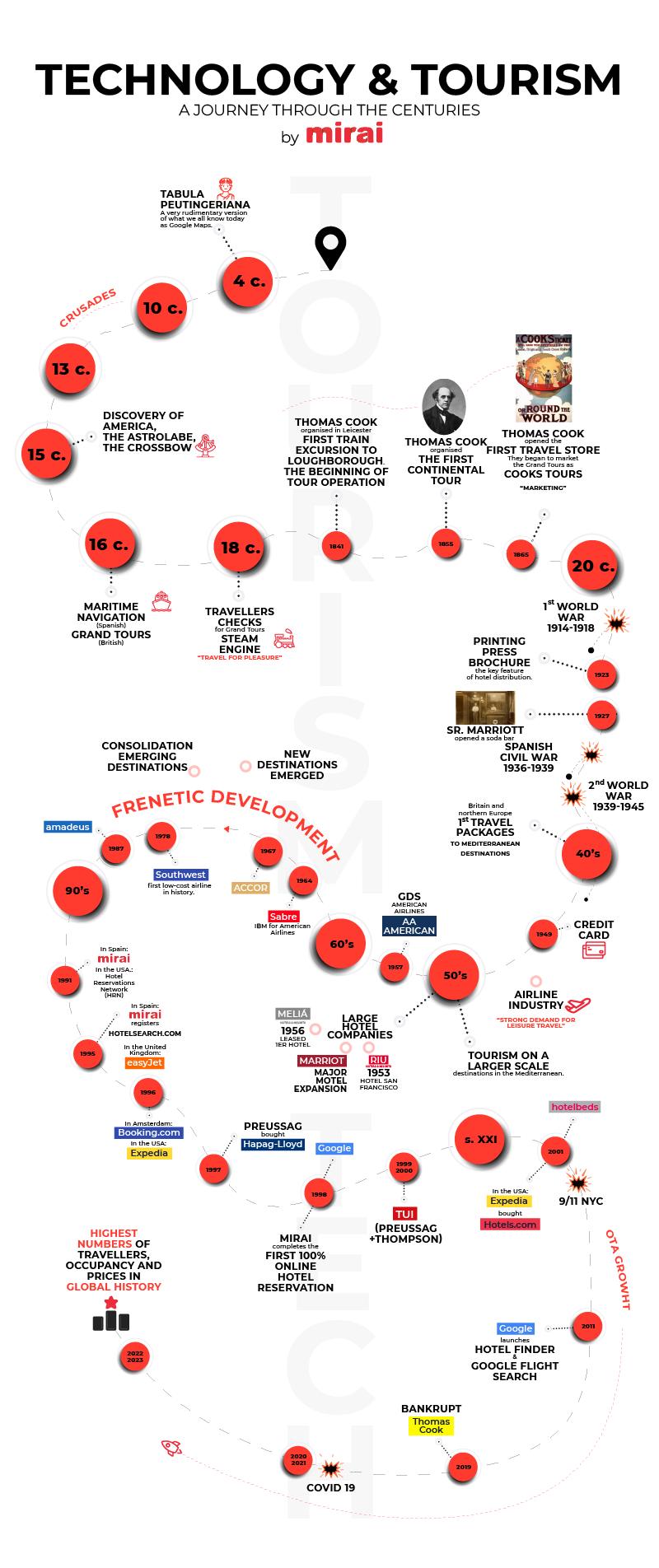En español, en français, em português.
 We would like to use this post to analyze the influence and relationship of technology with the tourism industry from a historical perspective, from its most distant origins to the present day. Let’s begin!
We would like to use this post to analyze the influence and relationship of technology with the tourism industry from a historical perspective, from its most distant origins to the present day. Let’s begin!
The origins of tourism
The hotel and tourism industries are as old as humanity itself, as people have always travelled by nature and through need since the beginning of time. If we analyze human behaviour regarding travel and accommodation from a historical point of view, we see that the travel and hospitality industries have always been, and will always be, closely related to technology.
In the 4th century, the Tabula Peutingeriana was an illustrated itinerarium of the ancient Roman roads. We can see the first incarnations of travel guides or a very rudimentary versions of what we all know today as Google Maps.
And although they were motivated by religion and geopolitics, the Crusades are considered by many to be the first major organized travel groups, and also depended on technology to be successful.
In the discovery of the Americas by the Spanish at the end of the 15th century, basic technology, such as the astrolabe or crossbow, were decisive in the success of an expedition that changed the world. A few years later, in the 16th century, Spain achieved the highest degree of professionalisation of maritime navigation, with the publication of fundamental works such as the “Art of Navigation” by Pedro Medina or the “Brief Compendium of the Sphera” by Martín Cortes de Albacar. Both Spaniards are practically unknown, although they made great discoveries such as the magnetic declination of the Earth or the measurement of the height of the stars.
The 16th century also saw the wealthiest classes in Great Britain beginning to organize Grand Tours throughout southern Europe, especially Renaissance Italy, as part of their education.
18th and 19th centuries: Tour Operation begins
By the 18th century, the Grand Tours had become very common among wealthy Europeans and led to a major innovation: the travellers check. This was a nominative means of payment or currency exchange which made it possible to travel without having to carry large amounts of cash. We’ll come back later to the subject of payment methods and their influence on marketing.
Throughout the 18th century, especially in Britain, the development of the steam engine led to unprecedented economic growth for the Western world. As a consequence of this economic and social development, in the 19th century, people began to want to “travel for pleasure” on a fairly major scale.
In July 1841, Mr. Thomas Cook organized the first train excursion to Loughborough in Leicester. The trip was made by 500 people, and curiously was intended to form part of a demonstration against alcohol consumption. So we can therefore say that the summer of 1841 saw the beginning of tour operation.
In 1855, Thomas Cook organized the first continental tour that included accommodation and meals, visiting Germany, France and Belgium. Ten years later, he opened the first travel store in Fleet Street, very near Covent Garden. The store sold travel tickets, travel guides, footwear and luggage. Additionally, they also began to market the Grand Tours as Cooks Tours. Know how was brought together with technology and business processes to create a product. This makes it one of the first marketing campaigns in the history of the travel industry.
In the period between the wars, in 1923, in what was then Prussia, a company called Preussag was founded. It was dedicated to mining, steel, oil and real estate, but was also involved in printing. Their printing press would produce the kind of brochure that would become the key feature of hotel distribution for decades. The Preussag company used advanced technology in a number of different fields, and would later go on to become the current TUI group.
In 1927, in the USA, Mr. Marriott opened a small nine-stool soda bar in Washington, DC. That was the beginning of what is today the largest hotel company in the world.
1940 – 1990: Huge Growth
The Second World War redefined the world on a geopolitical level. One of the consequences of the war was a large surplus of military material after it ended, including planes, ambulances, buses and other key elements of public transport. At the end of the 1940s, the first travel packages to Mediterranean destinations were sold in Britain and other northern European countries. These packages used military aircraft and, in many cases, the passengers on the ground were transported in vehicles left over from the war.
The 1950s saw tourism on a larger scale with the development of the first major tourism destinations in the Mediterranean. Large hotel companies were founded and began to grow. In Spain, the Riu family opened the Hotel San Francisco in 1953 and Gabriel Escarrer leased his first hotel in 1956. In the USA, the Marriott family began its major motel expansion.
The decades between 1960 and 1990 saw frenetic development, large hotel chains grew (Accor was founded in 1967), emerging travel destinations became consolidated and new destinations emerged. At the end of the last century, tourism became one of the leading global industries.
In parallel, in the USA, 1949 saw the birth of the credit card, which would become a major factor in world trade, especially for tourism. The airline industry was also growing exponentially due to the strong demand for leisure travel. That’s why American Airlines created the core of what would become the first Global Distribution System (GDS) in 1957. In 1964, IBM created SABRE (Semi Automated Business Research Environment) for American Airlines to handle the huge and growing volume of flight bookings. 1978 saw the birth of Southwest Airlines, the first low-cost airline in history.
1978 was also the year SABRE became a platform for travel agents, firstly for booking flights, and then later also hotels. In 1987, a group of European airlines created Amadeus as an inventory and distribution management platform.
1990s: the beginning of The Great Revolution
Given the huge number of events to highlight from the 1990s onwards, we’re going to list specific years with the most relevant historical events:
- 1991: Mirai is founded in Spain and Hotel Reservations Network (HRN, later becoming Hotels.com) in the USA. HRN only sold hotels over the phone.
- 1995: Mirai registers the domain hotelsearch.com and creates one of the world’s first hotel directories, evolving shortly afterwards into an online travel agency (OTA). The same year, Easyjet was founded in the United Kingdom, selling seats by phone and with the phone number painted on the side of the plane.
- 1996: Booking.com was founded in Amsterdam, and was not allowed to advertise its website URL in the top Dutch newspaper because it only accepted telephone numbers. Meanwhile, in the USA, Expedia started up as part of the Microsoft group.
- 1997: Preussag bought Hapag Lloyd, a pioneering transaction in the vertical integration of flights, travel agencies, hotels and destination services.
- 1998: Mirai completes the first 100% online hotel reservation. In that same year, Google was founded in the USA.
- 1999 – 2000: the TUI group was formed (result of the merger of Preussag & Thompson) and became the leading travel group in Europe. In the USA, given the difficulty of finding relevant, quality content on the Internet for organizing a trip, Steve Kauffer founded TripAdvisor.
Start of the 21st century
- 2001: 9/11 terrorist attacks in NYC. Expedia (USA Networks) buys hotels.com. Hotelbeds Foundation (part of First Choice, part of the TUI group). The global tourism industry comes to a screeching halt and hotels are left almost empty. OTAs begin their exponential growth and gain market share in hotel distribution.
- 2011: Google launches the Hotel Finder product and Google Flight Search travel tools to enrich search results for users.
- 2019: Thomas Cook goes bankrupt after 178 years of operations.
- 2020-2021: the COVID-19 pandemic breaks out. The global hospitality industry comes to an almost complete halt.
- 2022-2023: the tourism and hotel industries resume their activity, achieving the highest numbers of travellers, occupancy and prices in global history. Booking.com exceeds 100 billion in market capitalization.
Conclusion
The hotel industry has been constantly growing and evolving for centuries. Supply and demand have grown exponentially, creating one of the world’s leading industries, especially in recent decades.
Distribution has been one of the hotel industries key historical challenges, which is why large companies have developed in this area. Historically, technology has been a fundamental factor in the development of hotel distribution. In this perspective, it is obvious that proximity to customers and customer data, communication capacity and speed, brand value and access to room availability and prices have been, and always will be, keys to driving sales.
Marketing combined with technology now allows hoteliers to carry out these key activities directly and efficiently. This new context gives hoteliers the chance to be commercially and financially stronger if they so wish. But if they don’t take advantage of this opportunity, they will always require third parties to support their business model and deliver a large part of their revenues.



